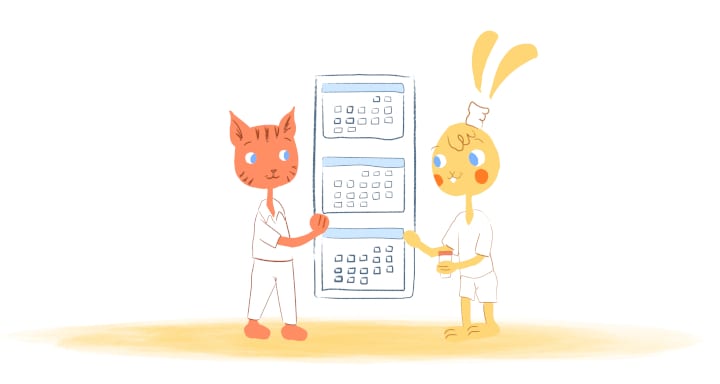

Whether you like it or not, if you want your life — both personally and professionally — to run a whole lot smoother then you need to be organized and have a schedule. If not, you can expect to be surrounded by chaos. Calendar scheduling mistakes are bound to happen.
When done correctly, having a schedule can help you complete tasks on-time, avoid taking on more than you can handle, work towards your goals, and achieve a healthy work-life balance.
But, what if you have a schedule and your life is still chaotic? It may be because of the following 10 calendar scheduling mistakes.
1. Not using a scheduling calendar app.
No disrespect to the weekly planner that you jot down your time with pen and paper — but if you’re not using an online calendar you’re missing out big time.
Unlike a weekly planner, desk pad calendars, or flip calendars, online calendars come with the following benefits:
- An online calendar can be accessed from pretty much any mobile device. This means you’ll always have your calendar with you so that you can easily view your calendar, as well as add new data like a new appointment or event details.
- You can use your calendar to schedule meetings and appointments from anywhere.
- You can set-up reminders so that you’ll never miss an appointment, meeting, or deadline.
- With an online calendar you can block time in your day to complete your priorities.
- If you have meetings or appointments that occur regularly you easily create recurring events in your online calendar.
You can also share your calendar with others so that they know your availability. This can eliminate those time-consuming back-and-forth emails when scheduling a meeting.
Even better, you can use a scheduling tool in conjunction with your online calendar. For example, Calendar uses machine learning to make smart suggestions on where and when to schedule a meeting.
2. Not working during your peak hours.
It’s not uncommon for people to attribute the key to their success to waking-up early. Personally, I love waking-up early. It gives me time to reflect, exercise, read, plan my day, and clear my inbox before anyone else is up — this means I’m not distracted and feel productive before the workday starts.
However, not everyone is a morning person. Some people are most productive at 10am, while others’ peak hours are between two p.m. and four p.m. When you identify when you’re most productive you can schedule those times for your most complicated tasks. This way you’re not forcing yourself to work on these tasks when you’re tired or unmotivated.
3. Focusing on the urgent, instead of the important.
“When you schedule your day — it’s common to put the easiest tasks first. Getting all the trivial things out of the way first seems the most efficient right?” asks Renzo Costarella in a previous Calendar article. In reality, the opposite is true.
It turns out that we have the most energy and focus shortly after waking-up. As such, it’s suggested that you “always tackle your most important tasks at the beginning of the workday” instead of those urgent tasks that only take a couple of minutes — this is called eating a frog.
Additionally, if you’re exhausted after completing these tasks it’s not that big of a deal “because the rest of your work should be a piece of cake.”
4. Overcommitting.
Warren Buffet has famously said, “The difference between successful people and really successful people is that really successful people say no to almost everything.”
This statement definitely can apply to your calendar as well.
Let’s say that you accept every meeting or appointment request. When does that leave time for you to work on your tasks or meet a friend for coffee?
I know you don’t want to disappoint people, but sometimes you just have to say “no” so that you don’t overcommit your time.
What’s worse is that this eventually means that you start doing things like double-booking appointments or scheduling back-to-back meetings. These are impossible to achieve because it’s just not possible to be in two places at once.
5. Not putting in buffer time.
You just booked a meeting with a potential client at 1pm across town. You then get an invite to meet with an investor at two p.m. back in your office. Do you really have time to make it back to your office by two p.m.? Do you have time to prepare for the next meeting? I doubt it.
You need to schedule buffer times throughout your calendar so that you aren’t perpetually late, unprepared, or neglecting your own needs like eating. Furthermore, you need this time to recharge and catch your breath. This is one of the top scheduling mistakes that I see.
Jeff Weiner, the CEO of LinkedIn, schedules “90 minutes and two hours of these buffers every day (broken down into 30- to 90-minute blocks).” He suggests that you don’t schedule anything and use this time to “think big, catch up on the latest industry news, get out from under that pile of unread emails, or just take a walk.” It’s really up to you. The idea is that you schedule time for yourself in a systematic way.
6. Letting others disrespect your time.
Sometimes we let others steal our time. That means instead of filling your calendar with your priorities, your whole calendar becomes filled with other people’s priorities.
Would you allow someone to steal your stuff right in front of your face? Then why do you let them steal your most important resource and commodity? Your time.
Calendar scheduling mistakes could be happening due to the following reasons:
- You’re hanging out with the wrong people, such as those who control every minute when you’re together or the ones you are constantly blowing you off.
- Wanting to be a team player so we say “yes” to everything.
- Always trying to help others when we don’t have the time.
- Trying to be available 24/7. If someone knows they can email you at midnight and get an immediate response then you can expect that this will become the norm.
7. Only filling your calendar with meetings.
Take a quick look at your calendar. Is there anything else scheduled on there besides meetings? If not then you aren’t using your calendar correctly.
You calendar shouldn’t be used merely to remind you of an upcoming meeting. It’s main purpose is to schedule time — not just for your work — but also time for life. This way you can:
- Turning tasks into tangible items.
- Focus only on the task at-hand.
- Practice working on your time management skills by devoting the right amount of time to specific tasks.
8. Calendar Scheduling Mistakes: Failing to optimize your meetings.
Speaking of meetings, they can be real time-wasters. That’s why you should optimize them before adding them to your schedule by:
- Having a clear purpose so everyone knows exactly what the meeting is all about. Don’t forget to send an agenda and materials in advance too.
- Invite only those who are necessary — ideally under eight. Remember, too many cooks in the kitchen is never a good thing.
- Have set meeting times and stick to it. Try to keep meetings as short as possible, like 15-30 minutes. If this is a problem, try a standing meeting. They’ve been found to be 34 percent faster.
- Don’t scedule status meetings. Instead use a tool like Slack or Trello to keep everyone updated on the progress of a project.
9. Underestimating how long a task will take.
I originally scheduled two hours to write this post. It took me three hours instead. It didn’t ruin my day since I planned to spend this day writing. But I did make a note of it so that the next time I write a similar article I’ll know to set aside three hours. However, this would be an issue if I had a conference call during that third hour.
While it’s always possible to know exactly how a long a task will take, you should start keeping a tab on your recurring tasks so that you can plan accordingly. This way you’ll be able to finish your priorities in one day without feeling pressured.
10. Having multiple calendars.
What do you think will happen if you have a calendar at work and another at home? Chances are that you’re going to plan a dinner meeting on the same night that you have a parent-teacher conference or night out with your college friends.
Avoid this from happening by using just one calendar that either has sub-applications or is color-coded. For example, you could color meetings blue, tasks, green, and personal obligations orange. Then when someone requests your time you can quickly look at your calendar to make sure that you’re available.










John Rampton
John’s goal in life is to make people’s lives much more productive. Upping productivity allows us to spend more time doing the things we enjoy most. John was recently recognized by Entrepreneur Magazine as being one of the top marketers in the World. John is co-founder and CEO of Calendar.